Whatever happened to the days when superheroes liked each other? When team-ups weren’t just about bruised egos and broken families? When did the Super Friends stop being, well… friends?
There was a time, decades ago, when the Justice League was just as much a relatable workplace comedy as it was about banding together to save the world. When we’d take time to appreciate who these heroes were, and how they related to each other, before they all strapped on their spandex to defend the planet from an alien overlord. In those years, nobody captured that dynamic like the unlikely friendship of the Justice League’s two most notorious misfits, Blue Beetle and Booster Gold.
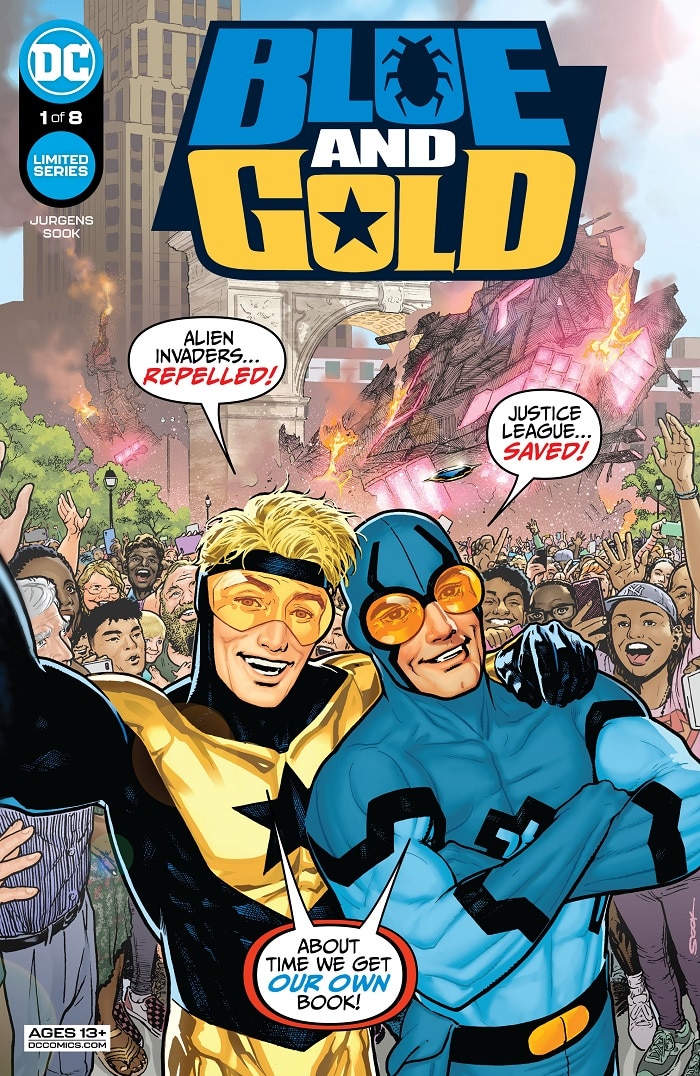
The Blue and Gold duo was a dynamic in which many of us saw ourselves—filled to the brim with impostor syndrome, standing around people who always seemed to have their own issues way more sorted out and finding comfort and acceptance in each other’s dysfunction. “Hey, at least I’m not the ONLY loser around here!”
We all know someone, or wish we knew someone, who we could let our guard down with and just laugh out loud like idiots at the absurdity of life. And in the DC Universe, that’s exactly what Ted Kord and Michael Jon Carter represent. And while recent years have conspired to keep them apart, the Blue and Gold team finally have their own long-deserved buddy comic premiering this week with Blue & Gold #1, 34 years after they first met. As Booster might say, “It’s about darn time!” But for those of you just joining us, here’s a quick primer on the long history of this historic Super Friendship.
Before They Met
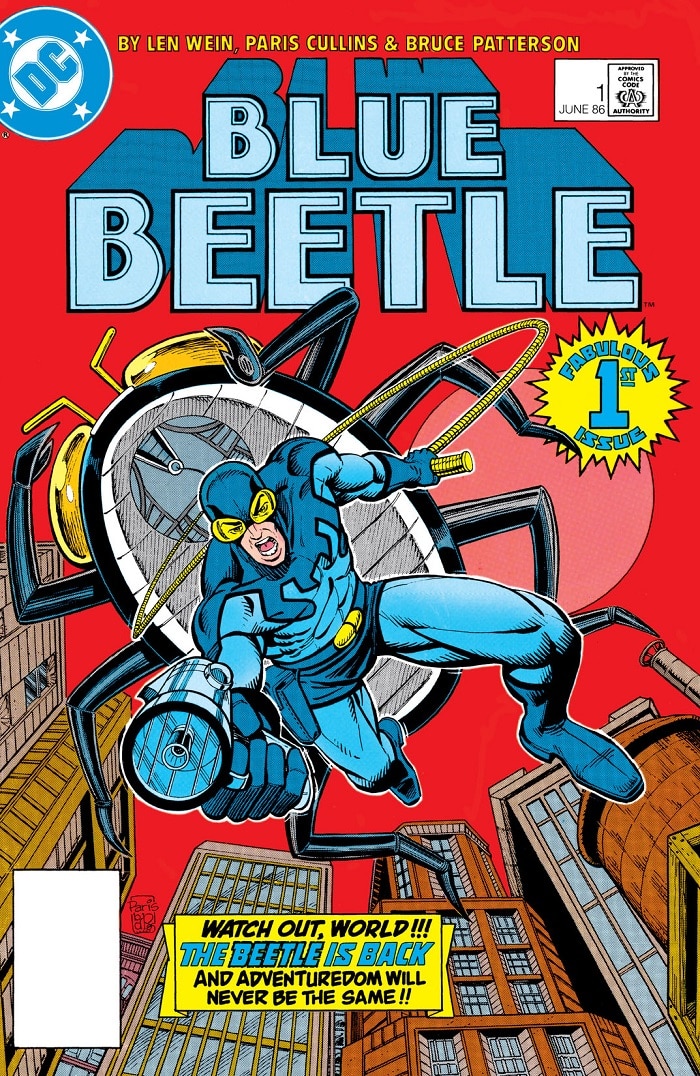
Prior to 1985’s Crisis on Infinite Earths, a meeting between Blue Beetle and Booster Gold was impossible. For one, Booster didn’t exist yet. For the other, Blue Beetle was being published at the time by an entirely different company—Charlton Comics, whose stable of superheroes like Blue Beetle, Captain Atom and the Question was inherited by DC in the mid-eighties.
When DC relaunched their entire comic line for the Post-Crisis era, the time came for both heroes to shine. 1986 introduced a new generation of readers to Ted Kord, a technologically savvy but personally insecure hero trying to live up to the impossible legacy left behind by his mentor Dan Garrett, the original Blue Beetle.
That same year gave us Booster Gold, a superhero designed specifically for the American dreams of second chances and lavish material excess in the 1980s. A disgraced screw-up from the 25th Century, Michael Jon Carter had the brilliant idea one night to travel back in time to the Golden Age of Super Heroes in the 20th Century, using relatively commonplace technology from his own era to launch himself to the public adulation and endorsement deals he so desperately craved. Booster was created by Dan Jurgens, who is writing this latest chapter in the character’s life with Blue & Gold.
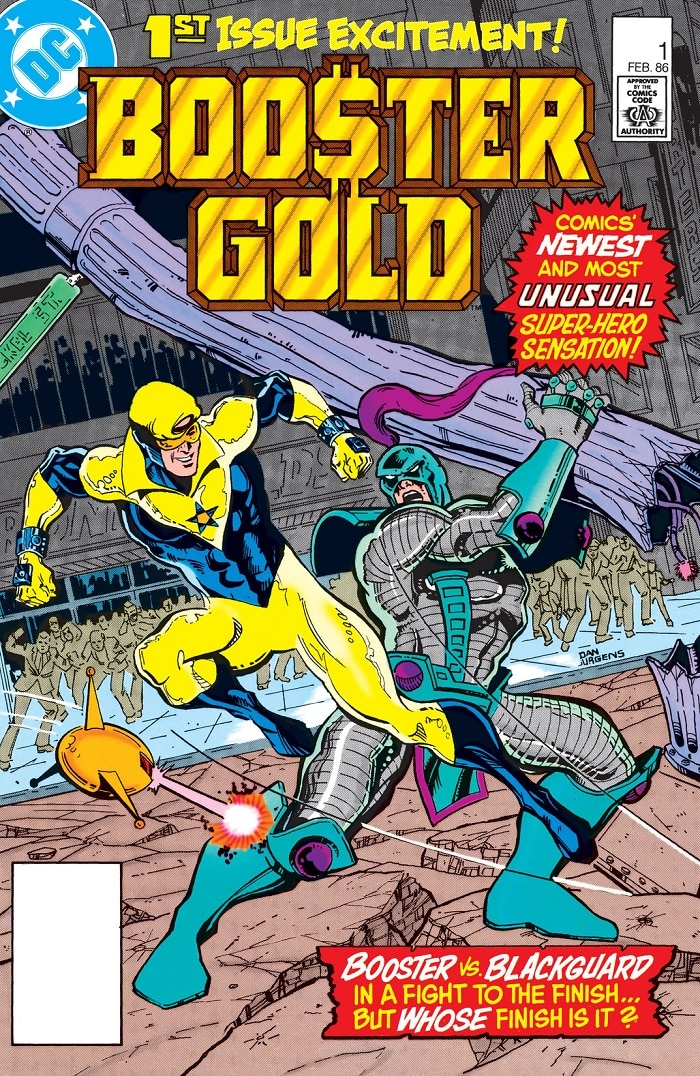
With one hero moored to the past, and the other to the future, these two freshmen in DC’s Post-Crisis world certainly came with something to teach each other. Whether they actually learned anything, though, is…up for debate.
Make Blue Friends…
A year after each of their DC books launched, a new Justice League came into being—one where smaller name heroes, give or take a Batman or Martian Manhunter, were given the chance to work together and accomplish what they couldn’t do alone. Blue Beetle made the roster by being there for their first mission together, in the Legends miniseries. In fact, it was Ted who suggested they call themselves the “Justice League.” But keeping in theme with his corporate interest background, Booster Gold’s inclusion was a decision made by the League’s business manager of sorts, wheeler-dealer Maxwell Lord.
Blue Beetle and Booster Gold worked together for the first time in 1987’s Justice League #4, using a clever deployment of force field technology to bisect the Royal Flush Gang’s oversized android, Ace—and unlike Ace’s torso, they’ve been inseparable ever since. But it’s a few issues and a series name change later, in Justice League International #8, where their dynamic was cemented forever. After moving the Justice League headquarters to Paris, Booster makes a bold attempt to demonstrate his way with the ladies by wooing a local, but is so flatly rejected that Beetle can’t help but double over with laughter.
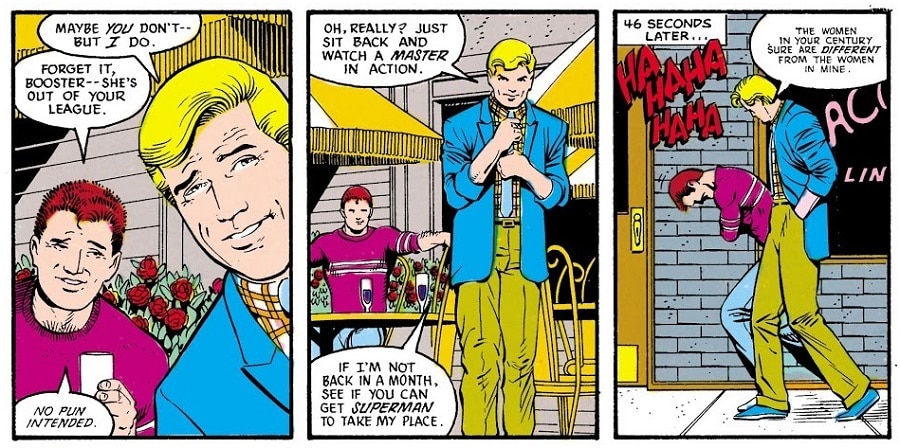
And later, when they discover that same woman, Catherine Cobert, is to be their Justice League liaison, well…
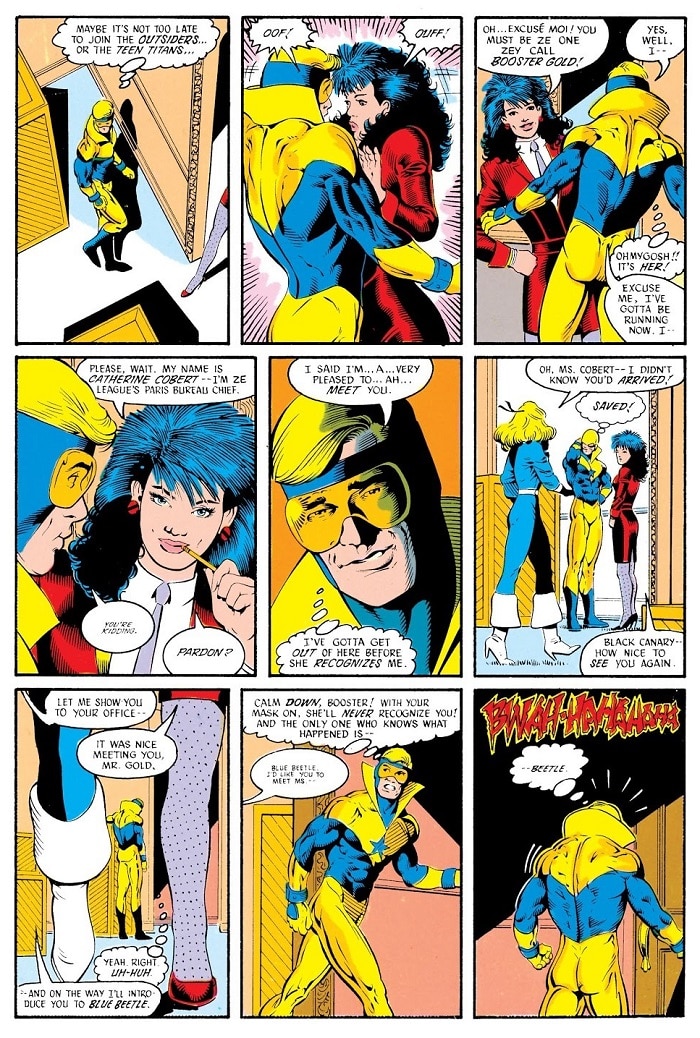
From that moment on, Booster and Beetle, or “Boostle,” as the relationship’s most devoted fans sometimes call them, drove the comedy and heart of the Justice League International era for years to come. They would pull pranks on Martian Manhunter together, start foolhardy business ventures together, and most importantly, make each other laugh while the “grown-ups” in the room were conducting serious business. For any kid in school who’s ever spent a droning lecture passing notes in the back of the room while barely holding back laughter, Ted and Booster were always supremely relatable. Together, they showed us that the face of justice could, on occasion, cross its eyes and stick out its tongue.
Time Crisis
Sadly, there comes a point where the good times must come to an end. That came in the lead-up issue Countdown to Infinite Crisis, when the never-completely-trustworthy Maxwell Lord was masterminding a scheme which would put the world under his control. Ted Kord found out about Lord’s plans one issue too early, and before he could convince anyone to believe him, Max Lord put a bullet through his head.
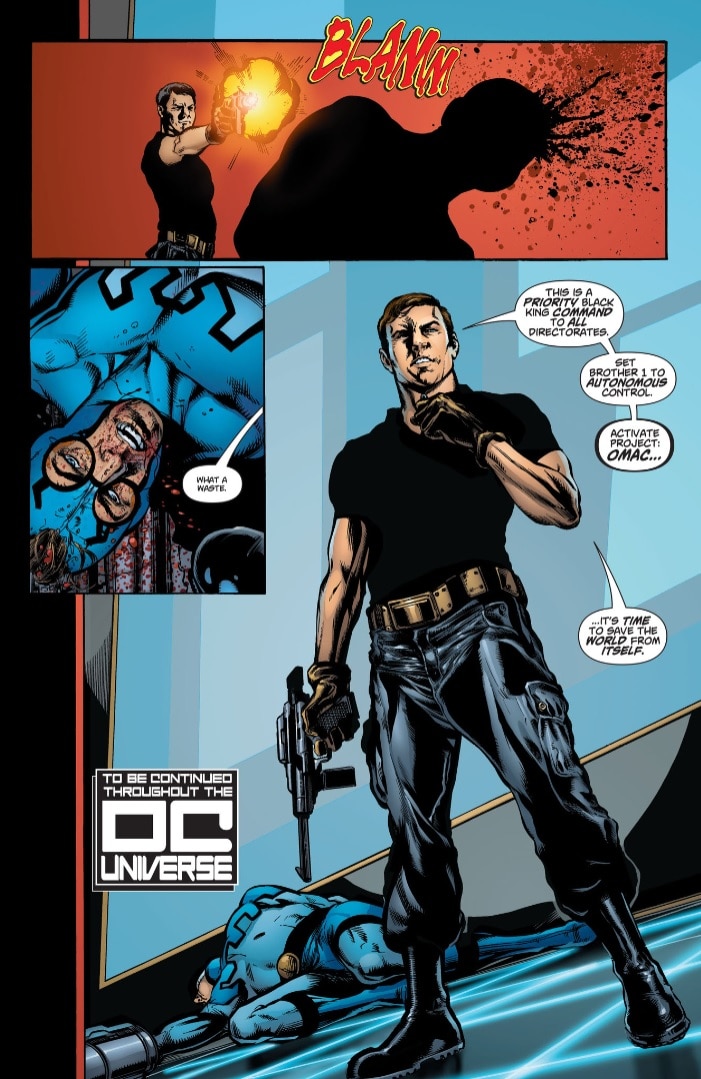
Soon after, Maxwell Lord would be dead by Wonder Woman’s hands, and Booster would be left without catharsis and without his best friend. In the maxi-series 52, and the subsequent Booster Gold series, Booster found a new sense of purpose as perhaps history’s most important superhero—a protector of the time stream. Though no one could ever learn of his importance to preserving the continuity of the universe, lest he be killed by time traveling enemies before he began, he earned some reward in his endeavors: through missions which took him to the past, Booster was allowed to spend time with Ted once more, though he could do nothing to prevent his impending death. (And the one time he tried, well…things didn’t go so great.)
At the same time, Booster and Beetle’s friendship was expanding beyond the reach of comics. Booster Gold developed a dynamic with Ted Kord in the Smallville season 10 episode “Booster,” and the Batman: The Brave and the Bold season 2 episode “Menace of the Madniks!” centers on a time-traveling adventure gone wrong where the otherwise incompatible Booster Gold and Batman mourn for their fallen friend.
But this is comics, after all, and rare is the death that lasts forever.
…But Keep the Gold
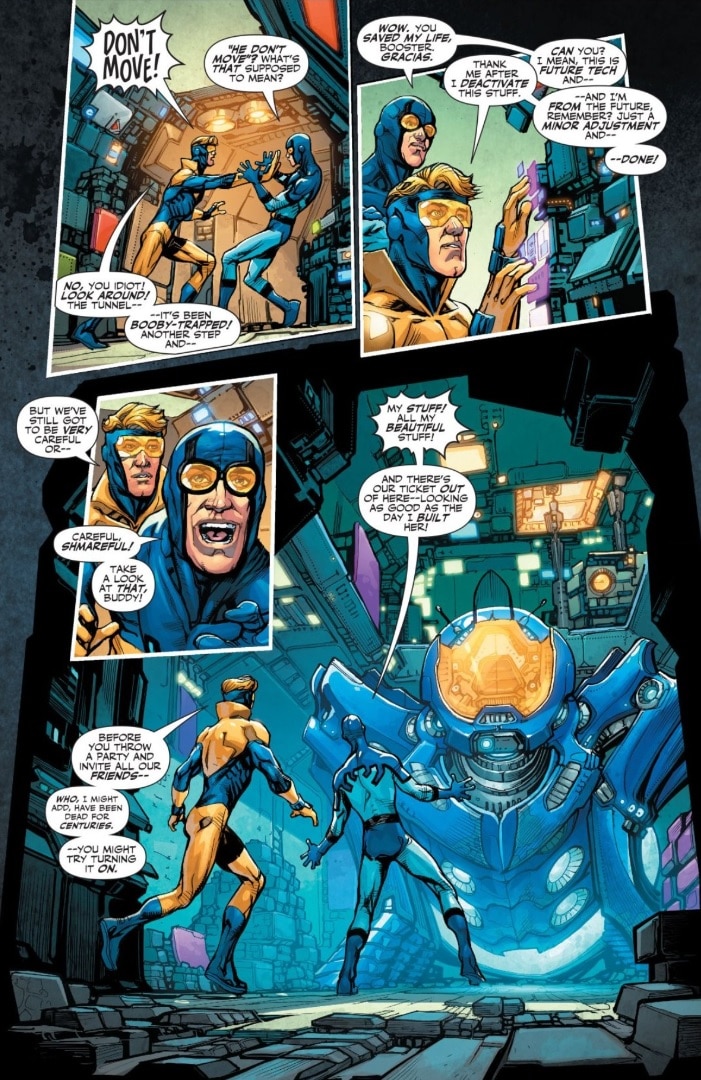
Keith Giffen and J.M. DeMatteis, the writing team behind Booster and Beetle’s JLI adventures, brought the team back together in the New 52 for their Justice League 3000 and its sequel, Justice League 3001—a “continuity-adjacent” series set 1,000 years in the future. As revealed later in the series, Justice League 3000 was set in a timeline where Maxwell Lord never betrayed the Justice League and where Ted and Booster at some point underwent a very Futurama-style cryostasis for further adventures in the 31st Century.
Meanwhile, in the main continuity, Ted Kord’s death was to be one of the many reversals made to the altered Post-Flashpoint timeline at the denouement of 2013’s Forever Evil. But Ted’s history as Blue Beetle remained unestablished until the “Rebirth” of DC’s prior continuity some years later, where he served as mentor to new Beetle Jaime Reyes in the 2016 Blue Beetle series. It would be years more until Ted was reunited with his counterpart—when Booster, suspected for a string of murders he didn’t commit in Heroes in Crisis, turned to Ted once more when he needed him most. After all, if anyone could understand what you’re feeling when the whole world doesn’t believe you, it’s Ted Kord.
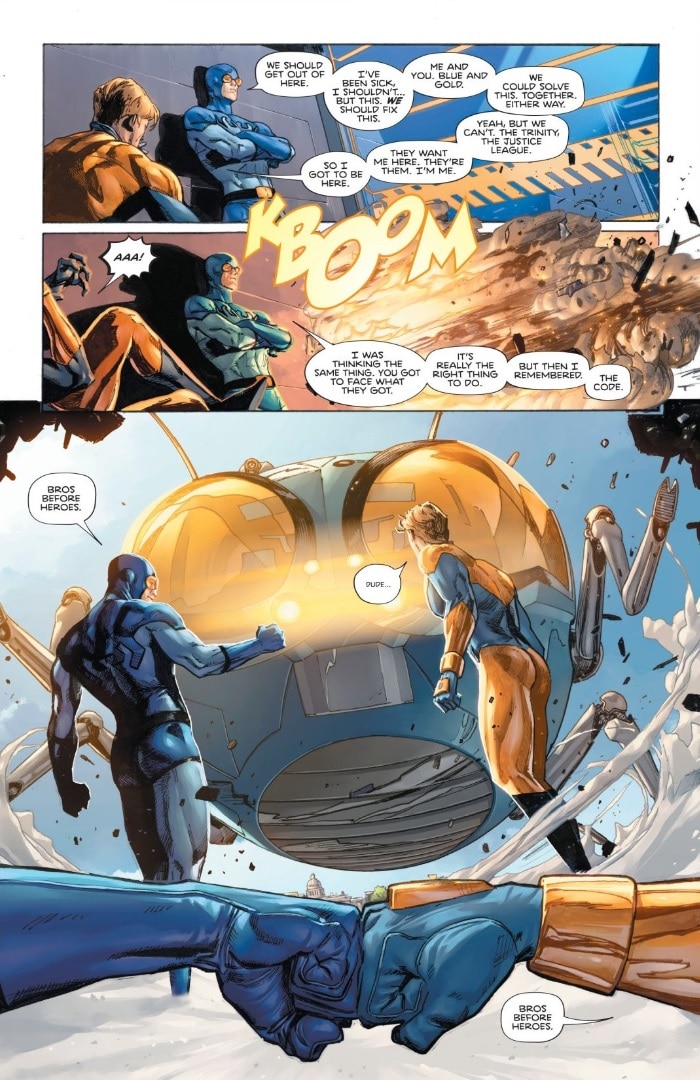
And so, with Booster’s name cleared and Ted finally back in blue spandex, the time is right for a return of one of the most celebrated partnerships in DC history—one emblematic of an era when heroes could be silly and entirely unashamed of that silliness. And in this decade of social media stardom, the iron is hotter for an image-obsessed hero like Booster than it’s ever been before. Blue & Gold #1 is out now, and it’s time to laugh again. At ourselves, at our heroes, at our world and our hobbies. Loud, unashamed and like idiots. Life is too short to keep it in.
BWA-HA-HA-HA-HA-HA-HA!!!
Blue & Gold #1 by Dan Jurgens and Ryan Sook is now available in print and as a digital comic book.
Alex Jaffe is the author of our monthly "Ask the Question" column and writes about TV, movies, comics and superhero history for DCComics.com. Follow him on Twitter at @AlexJaffe and find him in the DC Community as HubCItyQuestion.




















